Skift Take
Those with $50 million in the bank aren’t average, so it follows that neither are their vacations. In other words, Fitzgerald had it right: The very rich are different from you and me.
By Sarah Kopit | June 23, 2024
According to Jimmy Carroll, containing the kidnapping “victims” is generally the hardest part of the trip to execute.
Here’s the set-up: A wealthy entrepreneur is about to turn 40. To celebrate the milestone birthday, he wants to take his closest friends on a vacation they’ll never forget. It’s a tall order, given these are the Masters of the Universe who have done … a bit of everything.
Enter Carroll, co-founder of the ultra-exclusive, supremely expensive travel planning company, Pelorus.
For this trip, the team dreamed up a faux kidnapping in a remote part of South East Asia. The birthday boy (and a handful of hired actors) were the only ones in on the ruse.

It helps that both Carroll and his co-founder, Geordie Mackay-Lewis, are ex-British military, and specialize in reconnaissance and extraction.
The adventure started with the group exploring the world’s largest cave system, the Son Doong, in Vietnam. It was during the first part of the trek that Carroll and his team were able to psychologically profile the unwitting guests.
Each of the travelers was asked a battery of questions about how they react to stressful situations and their feelings about being underground. That provided excellent cover to hide the actual intention of the questioning. “Ten percent [of the profile] was about the cave system,” Carroll remembers. “Ninety percent was about the kidnap,” he says with a grin.
Leading up to the trip, they created elaborate backstories for the actors. Everyone had to sign waivers. Extra insurance was purchased.
But it was still containment that was the biggest hurdle. “You don’t want someone running into the jungle for their life.”
Carroll says once they got into it, everything went according to plan – except for an especially astute friend who started to get suspicious. “One guy we had to separate. He started to smell a rat,” he said. “But that actually played into our hands.”
That trip was a success. The client was thrilled. It’s what Carroll describes as the most complex and challenging travel experience he’s planned since starting Pelorus seven years ago.

And if you’re thinking you’ve seen this movie – you have. “The Game” starring a youngish Michael Douglas and Sean Penn, tells the story of a successful banker who participates in an over-the-top, personalized, real-life game as a birthday gift from his brother. Chaos and danger ensue.
Pelorus actually does its own version of “The Game,” as well. “People want their senses pushed,” says Carroll, opining on the trends currently in demand with the monied set.
“Our clients are well-traveled and time-poor. They’re looking for access to something out-of-the-ordinary, something they and their friends haven’t done yet.”
The New Social Currency
For the ultra high net worth traveler – those who typically have assets exceeding anywhere from $30 to $50 million – it’s these intense, experiential travel adventures that have become particularly en vogue.
In a post-pandemic world, the super rich are seeking trips that offer exceptionally unique experiences heavy on exclusivity, authenticity with extreme measures taken to ensure their safety. They’re looking for once-in-a-lifetime adventures that are the envy of friends (and enemies). Mere opulence will no longer do.
“A lot of our clients are high profile or senior business executives, and are therefore very security conscious,” Carroll says. Pelorus leans heavily into its founders’ military training. Both Carroll and Mackay-Lewis did tours in Iraq and Afghanistan. For certain high-profile clients, one or both of them are personally on-site for the vacations.

Geordie Mackay-Lewis and Jimmy Carroll. Source: Pelorus
The well-heeled are now clamoring to race Aston Martins in England or hang with the emperor penguins in Antarctica. They want to fly to space or dive into the deepest depths of the ocean. The echoes of Jules Verne are everywhere.
In the coming year, Pelorus will take over the actual Orient Express for a birthday celebration. This trip has been two years in the making. After some prodding, Carroll would only give the cost as, “multiple, multiple millions.”
And the demand for adventure by the young and privileged is only increasing. 81% of travelers making over half a million dollars a year say they are very likely to seek out thrilling and adventurous activities in their luxury travel experiences, according to Skift Research. A whopping 78% of that group say they plan to boost their travel budgets for the coming year.
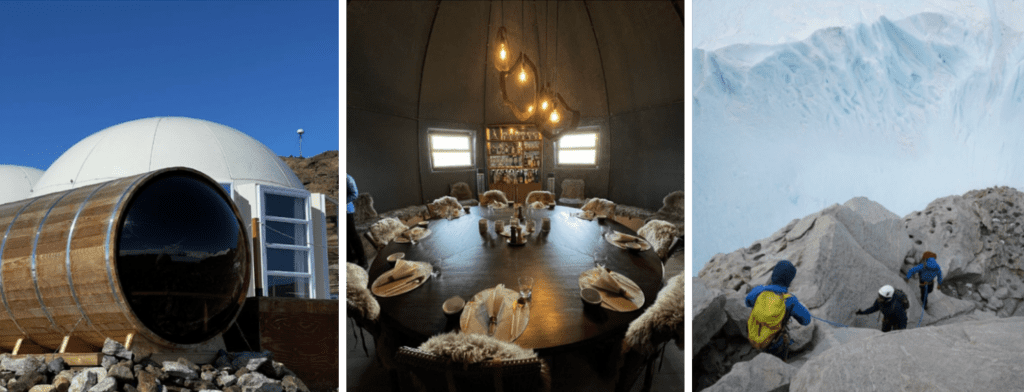
Which, if you’re doing the math, translates into Big Money. The global luxury travel market was valued at $1.67 trillion in 2022 and it’s expected to more than double over the next decade, reaching $3.7 trillion by 2032, according to Spherical Insights.
“It doesn’t matter if you’re doing a kidnapping or a honeymoon or a wedding anniversary,” Carroll stresses. “It’s all about attention to detail, personalization and creating an unforgettable experience.
To Boldly Go Where No One Has Gone Before
So what to do after you’ve seemingly done everything, gone everywhere? The answer increasingly means either looking up (way up) or down (way down).
Humanity’s current space-minded billionaire set – the trio Bezos, Branson and Musk – are leading the fledgling tourism space race, already sending civilians into orbit at a cost of multiple millions a pop.
This is hardly affordable, even for the extremely rich.
But space tourism is widening and going mainstream at a remarkable rate. The U.S. government now has a Space Force and the moon has a time zone. Hilton is designing the interiors for Starlab, the next iteration of the International Space Station.
The global space economy is expected to reach $1.8 trillion by 2035, up from $630 billion in 2023, says the World Economic Forum. The space tourism market will take in about $4 billion of that by 2030, according to UBS.
Artist rendering of Starlab Station. Source: Hilton
For now, there are far fewer seats available than interested parties. But, “every mission gets us one step closer to increasing access to space,” Blue Origin told Skift. And there’s a feeling among all in the industry that prices will come down quickly.
To fill the void, there’s a host of other new flying machines and space balloons to scratch that airborne itch at a more reasonable(ish) price point.
Coming later this year, several companies intend to take passengers up about 100,000 feet in pressurized capsules lifted by hydrogen space balloons. Flights typically last about six hours. At their highest point, passengers see both the curvature of the Earth and the darkness of space.
No training is needed. Cocktails and hors d’oeuvres will be served.
Artist Rendering of a spaceballoon. Source: SpaceVIP
Over at Pelorus, they’ve teamed with OceanSky Cruises to offer floating expeditions above the Arctic in an airship. These airships – which I confirmed is just a fancy way to say blimp – promise a cleaner way to view both the North and South poles.
Pelorus’s Carroll expects over the next 5-10 years that the travel community will see a huge increase in cleantech aerospace creations like electric vertical take-off and landing aircraft – or EVTOLs – that use electric power to hover, take off, and land vertically.
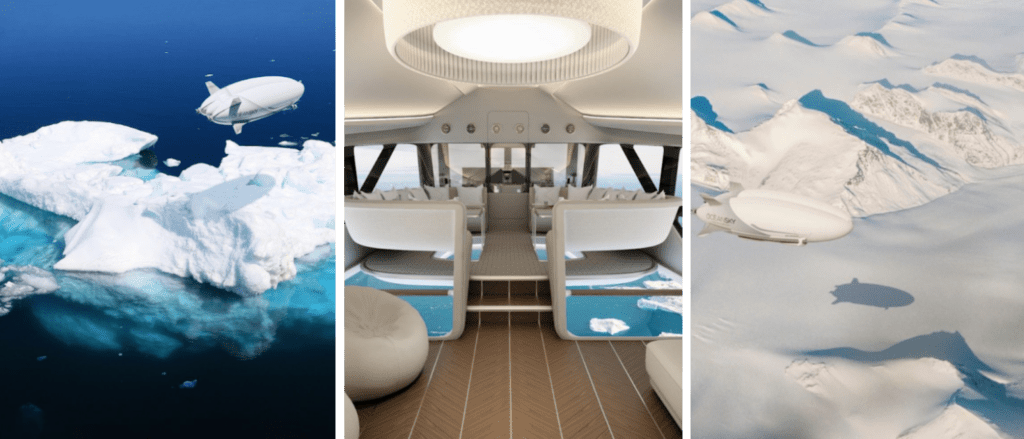
Artist renderings of airships. Source: Pelorus
But for those looking for still more adventure, there’s often a significant nexus between those Earthlings willing to be blasted off in a rocket and those who want to dive into the deepest depths of the world’s oceans.
This hasn’t gone unnoticed by exclusive tour providers who are often experts in arranging both types of trips for the right customer.
Take the luxury outfit SpaceVIP. While it has the word ‘space’ in its name, it offers three types of exotic experiences – those with Space operators, Earth operators and Ocean operators.
20,000 Leagues Under the Sea
The deep sea is also increasingly a place for adventurous tourists.
The Hadal Zone, named for the Greek god of the underworld, Hades, is understood by scientists as depths from 6,000 to 11,000 meters below sea level. Known for its extreme pressure, total blackness, and almost freezing temperatures, this is where you’ll find the Mariana Trench and its cavernous crevasse, Challenger Deep. It’s the lowest point in the ocean and a perennial Hollywood fascination. If you saw “The Meg,” that’s where she lived.
This May, real estate billionaire Larry Connor said that he wants to take a sub to see the shipwreck of the Titanic. That’s the same spot where five people were killed in 2023 when a submersible built by the company OceanGate imploded, leading to increased scrutiny of the industry.
The submersible Connor intends to use will be built by Triton Submarines, the gold standard maker of recreational submersibles. They cost anywhere from $2.7 million to $35 million a piece.

Triton submersible. Source: Triton
They supply high end hotels, cruise ships and individual explorers alike. Ray Dalio, the founder of Bridgewater Associates and James Cameron, director of the movie Titanic, have both partnered with Triton.
“We had a client come to us and say, I’ve skied to the North and the South Pole. I’ve climbed the highest peak on the seven continents, but I’m amazed to find nobody’s ever visited the deepest point of five oceans. Can you build us a sub to do that?” says Craig Barnett, Triton’s director of sales. “So we actually did that.”
Dives like that one run about $750,000.
“It used to be to take a photo of your Gucci handbag or your new Ferrari or whatever and put it online,” Barnett says. “Now that seems gauche. So everybody’s looking for unique, meaningful experiences that you share with their friends and families.”
But, but, but, but …
Let’s confront the elephant in the room, shall we?
With rampant income inequality across the globe and the effects of climate change ravaging our environment, should anyone even be able to spend $1.5 million to fly on a private jet for a worldwide whisky tour? Or eat a Michelin-starred meal suspended from a space balloon 20 miles above earth? Or play with the penguins in their natural habitat, which, until recently, was unsullied by human hands?
The providers of these luxury experiences know you’re asking yourself these questions.
“A half a million dollar meal at the edge of space? Do we need more rich assholes doing that?” quips SpaceVIP CEO Roman Chiporukha. It was his team who arranged for celebrity chef Rasmus Munk to create a menu for a six hour space skimming balloon ride.

He thinks the answer is yes, noting the many things that society takes for granted that originated from space technology (the list is long and includes wireless headphones, your memory foam mattress and the humble Dustbuster).
“So it’s important to educate the public,” he says. “Once they’re educated, they’ll take more interest. Once there’s more interest, they’ll want to buy, then you’ll have economies of scale.”
On a civilian Triton dive to the bottom of Challenger Deep, the company was able to collect over 200,000 scientific samples and specimens. From those, scientists discovered 14 new species that have never been known to exist.
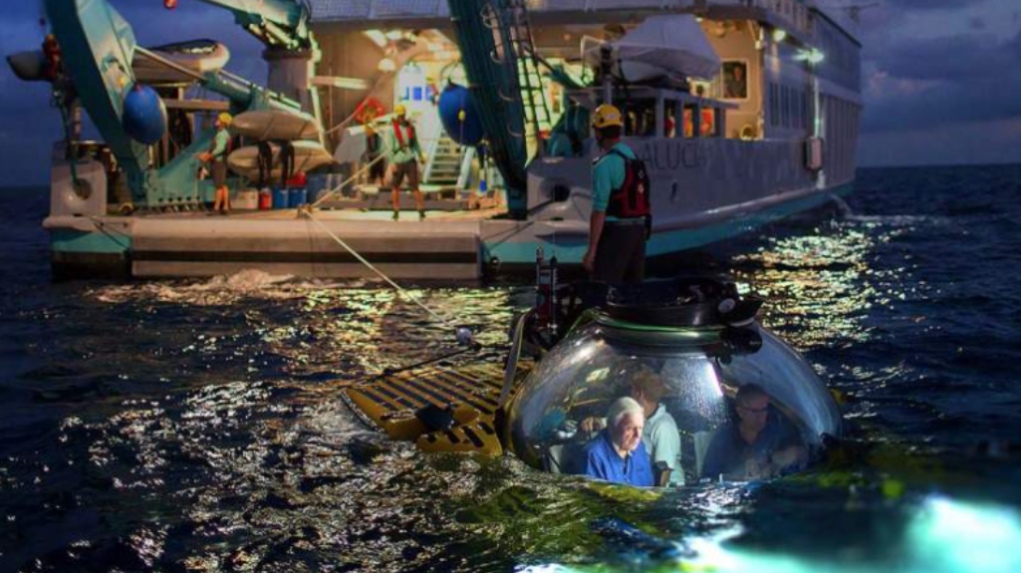
Triton 3300/3 dives the Great Barrier Reef with David Attenborough. Source: Triton
Pelorus’s Jimmy Carroll points to the distribution of wealth from million-dollar vacations. “The money was made elsewhere,” Carroll says. And now “has been distributed into countries which didn’t have the money to begin with.”
And like many other ultra luxury outfits, Pelorus also has a philanthropic wing, the Pelorus Foundation, which aims to protect at-risk wildlife and environments.
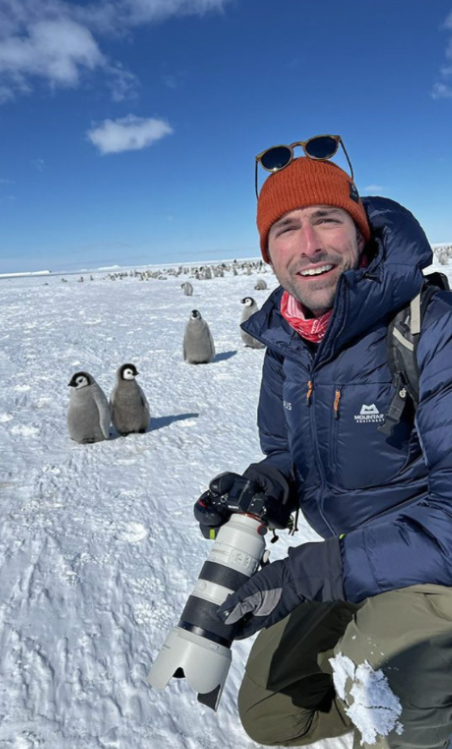
At Blue Origin, its non-profit, Club for the Future, promotes STEM learning for kids. And it’s connected to the company’s long-term vision – to build a road to space to benefit all of Earthlings.
“People who fly to space return to Earth with a different perspective about our planet,” Blue Origin told Skift. “They recognize its fragility and why we must preserve it.”
But despite any technological leaps or philanthropic and scientific efforts, these controversies show little chance of abating while the demand for unique, high-stakes travel adventures grows.
“We’ve always had problems on this planet,” says Chiporukha, but, “we are explorers by nature.”
Source: Pelorus
Sarah Kopit is editor-in-chief at Skift. Contact her at [email protected]
Graphics by Beatrice Tagliaferri
Have a confidential tip for Skift? Get in touch
https://news.google.com/rss/articles/CBMiXmh0dHBzOi8vc2tpZnQuY29tLzIwMjQvMDYvMjMvc3BhY2VzaGlwcy1zdWJtYXJpbmVzLWtpZG5hcHBpbmdzLWhvdy10aGUtdmVyeS1yaWNoLXZhY2F0aW9uLW5vdy_SAQA?oc=5
2024-06-23 21:10:12Z
Bagikan Berita Ini

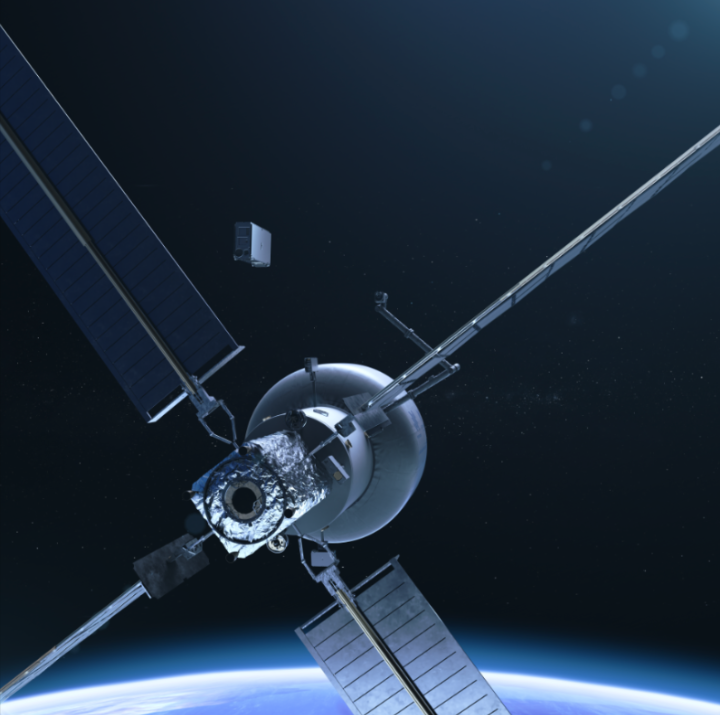
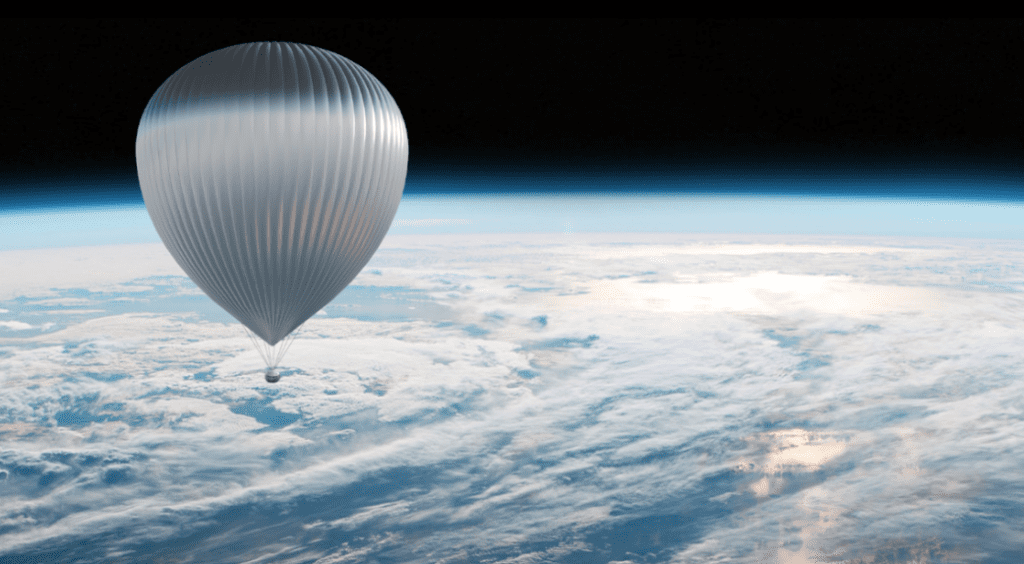














0 Response to "Spaceships. Submarines. Kidnappings. How the Very Rich Vacation Now - Skift Travel News"
Post a Comment